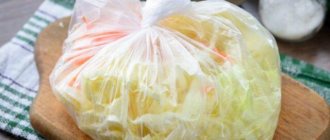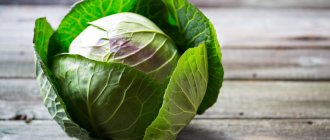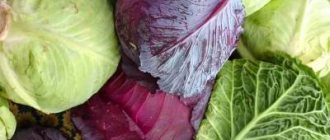How to store sauerkraut so that it remains tasty and retains all its beneficial properties? This question is relevant primarily for those who buy the product in large quantities or independently make sauerkraut in reserve. Storing sauerkraut is not that difficult, but there are still clear requirements, by following which you can provide yourself with this product for many weeks to come.
Traditional container for pickling cabbage - wooden barrel
Choosing the right cabbage for pickling
For this purpose - pickling - only late-ripened varieties of cabbage are suitable. Therefore, the preparation is often done before winter and for a long time, fermenting a large volume of leafy vegetables so that it lasts until spring. Also, late-ripening varieties are chosen because of their increased density, which also increases the taste characteristics of the pickles.
Cabbage, which reaches technical maturity in the summer season, is a good addition to vitamin-rich vegetable salads. But when fermented, it cannot sit for long. Under the influence of table salt, the fibers of cabbage leaves of early and medium varieties soften, lose some of their vitamins, taste and do not crisp. At the same time, not all cabbage heads are suitable for pickling, but only those forks that meet the following characteristics:
- when squeezed, the cabbage head does not deform and retains its elasticity;
- there is no damage on the surface of the cabbage leaves;
- the stalk is light green or cream, without rings or other dark markings;
- The cabbage head does not have limp, rotten or frostbitten leaves.
On a note! For long-term storage of sauerkraut, you must follow all recommendations. If the forks have been damaged, the pickled vegetable will have a shorter shelf life. Also, you need to take into account that early or middle varieties can be fermented, but such cabbage will only be tasty for a few days, then it begins to sour.
Selection of varieties for sourdough
The taste of the product and its ability to be stored for long periods after fermentation largely depend on the correct choice of cabbage variety and the good condition of the cabbage heads. For sourdough in winter, it is customary to use late-ripening and mid-ripening varieties.
Even those heads of cabbage that were slightly affected by the first frost will do. This circumstance increases the taste and makes the product crispy.
The best varieties for fermentation:
- Wintering;
- Belarusian;
- Present;
- Amager;
- Moscow late;
- Slava and others.
In addition to those listed, hybrid varieties are suitable for pickling, for example:
- Artia F1;
- Salting miracle F1;
- Kvashenka.
The choice of variety for cultivation should take into account the climatic conditions of the region. The following varieties are more adapted to the conditions of Siberia:
- Anniversary F1;
- Megaton F1.
At the same time, the cabbage heads should be ripe, dense and healthy. The weight of each must be from 0.7 kg and above.
Storage utensils
How long sauerkraut can be stored in the refrigerator or in another place depends on the container in which it is kept. Previously, only oak barrels or other smaller containers were used for this, but now there are more types of containers suitable for storing dishes. Moreover, if you choose wooden containers for storing the product, you must take into account that the material can impart its aroma to the product. Therefore, if the dishes are old, the sauerkraut will have an unpleasant aftertaste.
The best container for storing the product is one made of glass or ceramic. Such dishes actually do not absorb third-party odors compared to wood. In this case, a container for storing sauerkraut made of steel or aluminum is not a suitable choice. The product will receive some metallic aftertaste, which will significantly degrade its original flavor characteristics. If there is no other utensil other than metal, then you need to choose enameled one, the coating of which does not have any damage - chips, cracks.
How to tell if cabbage has gone bad. What to look for when choosing cabbage?
To understand how to choose the right cabbage, you need to remember the basic rules for purchasing this vegetable.
- Choose heads of cabbage with fresh, unpicked leaves. They should fit tightly to each other and not create the effect of an open fruit.
- Avoid fruits with brown or black areas, even if they are small. This indicates damage by fungi or putrefactive bacteria.
- Inspect the leaves for insect damage, which will show up as grooves or other blemishes on the leaves. Their large number suggests that it is better not to buy such cabbage.
- The head of cabbage must be strong. If when squeezing there is a feeling of softness and airiness, it is better not to choose it, as this indicates staleness or damage to the fruit.
- The leaves should be a rich green color. If they are dull, this does not speak in favor of such heads of cabbage.
- If cabbage has yellow or wilted leaves, it means it is lacking in freshness.
- The heads of cabbage should look clean and smooth, without obvious traces of chemical treatment or signs of frostbite.
- Significant mechanical damage will lead to a rapid loss of vitamin C, so fruits with them should be avoided when choosing.
- If stored improperly, cabbage begins to sprout, which can be seen with the naked eye. Therefore, not only choose smooth, strong heads of cabbage, but also place them in the refrigerator at a temperature of 0 to 4 degrees if you do not plan to use them immediately after purchase.
- The presence of a large number of dry layers in the heads of cabbage (parchment of the inner leaves) is also a defect, due to which the fruits should not be purchased.
Storing sauerkraut
Fermenting cabbage is quite simple, but preserving its freshness is more difficult - for this you need to follow all the rules and provide certain conditions for harvesting. It’s better when the product is prepared a little at a time, but when there is nowhere to keep fresh cabbage forks - for example, in an apartment, a large volume of vegetables is fermented at once. But keeping it fresh and suitable is quite difficult, since there is not much space in the refrigerator, and the basement is not always accessible. Storage conditions and freshness of sauerkraut are interrelated.
Temperature and humidity
It is recommended to keep sauerkraut at a temperature that is close to 0˚ C, but does not exceed +3...+4˚ C and not minus. However, you can leave the product at +10˚ C for a short time, but in this situation, fermentation will go further and the risk of peroxidation of the shredded leaf increases. If the thermometer mark is below 0˚ C, the product will begin to freeze, and after thawing it will lose its original structure - it will become soft and stop crunching. Because of this, sauerkraut is not kept on the open balcony in winter, but is sent to the refrigerator, underground, or glazed loggia.
Protecting pickles from mold
On the surface of the brine, when sauerkraut is kept in a pickling container, a whitish coating appears that looks like mold. This phenomenon is the result of the activity of yeast fungi and is actually classified as mold, which negatively affects the product. When such a film appears, the pickle loses its taste and original consistency, and the product becomes loose. You can solve the mold problem by adding mustard or horseradish to sauerkraut. This processing of the workpiece prevents the development of yeast fungus and gives some piquancy to the product.
Attention! You must not overdo it with the amount of horseradish or mustard powder, as these components have a specific taste and in large quantities they can spoil the sauerkraut, making it overly spicy.
It is permissible to use not only mustard powder, but also whole mustard seeds. They are folded into a gauze bag and placed in a container in which sauerkraut is kept. It is better if the mustard seeds are approximately in the middle of the pickle. To prevent the development of yeast fungus, horseradish is crushed - using shavings. But, this ingredient is added to sauerkraut only after it is ready. If you add horseradish earlier, the vegetable may not ferment, but will only be salted - if there is enough salt.
Brine quantity
Sometimes sauerkraut is stored without brine - it is drained. But you can’t do this, since the brine retains vit. C present in pickles, preventing its rapid destruction. Therefore, do not drain the liquid and make sure that it covers the shredded sheet completely. For this purpose, oppression is used. The absence of brine actually has no effect on the taste characteristics, but the usefulness of the product decreases. Therefore, the salted liquid is drained only immediately before serving the sauerkraut.
Using Preservatives to Keep Pickles Fresh
The main value of the product lies not only in the high content of vit. C, but also in an increased volume of coarse fibers, which have a positive effect on digestive function. However, the shelf life of the product is limited and to increase its shelf life, it is acceptable to use some preservatives. To do this, use the following:
- Sugar helps preserve the taste characteristics and density of the pickle. This preservative is poured in a thin layer on the surface of the sauerkraut in the container in which it is kept.
- Table vinegar is also suitable for increasing the shelf life of pickles. This preservative is added in a small amount to the container in which the workpiece is kept. But, you need to take into account that acetic acid slightly changes the taste characteristics of the pickle.
- You can add more table salt when preparing sauerkraut, but the taste characteristics of the pickle will be different and not entirely traditional. This pickle is more suitable for use as one of the ingredients in hot dishes.
- Vegetable oil is also suitable for prolonging the freshness of sauerkraut. It is poured into a container so that an oily film appears over the entire surface of the brine. It will stop air contact with the workpiece, which will inhibit the reproduction and development of pathogens that cause rotting.
On a note! When the pickle is over-acidified, even despite the preservatives used, it can be used to prepare cabbage soup or another similar dish. Before adding, sauerkraut is washed with cold running water. Also, 1 tsp helps to improve the situation somewhat. sugar (approximately 0.5-1 kg of product), added to the pickle before serving.
How to prevent mold from appearing
After some time, redness caused by pathogenic yeast may appear on the surface of the containers with the workpiece. As well as mucus and flabbiness of the product, which arose as a result of the development of aerobic bacteria that secrete cellulose-degrading and pectolytic enzymes. You can eliminate fungal mold using natural ingredients:
- Corn and olive oil poured on top of the workpiece. The fat in the oil forms a film that does not allow oxygen to pass through. It also prevents the development of psychrophilic bacteria, which give cabbage a bitter taste.
- Seeds and mustard powder wrapped in cheesecloth placed inside a container of cabbage will prevent the growth of Rodotorulla yeast, which produces red-pink carotenoids.
- Horseradish twisted in a meat grinder helps to neutralize groups of microorganisms that convert sucrose into the polysaccharide dextrin, causing mucus in the product.
Worth knowing!
Horseradish rhizomes contain essential oils that prevent the normal development of lactic acid bacteria. Therefore, the phytoncidal vegetable should be added only after the fermentation process.
Storage location for fermented product
It is believed that a cellar or basement is a suitable place for storing sauerkraut and other pickles. This is due to the fact that in the basement the temperature regime is optimal for maintaining the freshness of such products. Also, sunlight does not enter the underground, contact with which is contraindicated for pickles, since under the influence of ultraviolet radiation they begin to rapidly deteriorate. In addition to the above, in a good cellar or basement, air humidity levels are optimal for keeping pickles fresh.
However, there are also negative aspects of storing sauerkraut in the basement. So, if pickles are kept underground, the likelihood of mold developing is higher. And you cannot send sauerkraut to the basement or cellar in the case of an apartment. In this situation, a glazed balcony, loggia or refrigerator is a good place to store pickles. It is also acceptable to keep sauerkraut in a cool pantry. At the same time, in a warm room, where the temperature is above +18˚ C, the product is added in portions - one time at a time. The remaining cabbage, if the entire volume brought was not eaten immediately, is not put back into the brine - it is stored separately from the main volume of the workpiece, in the refrigerator.
Cellar storage
You can store pickles underground for a long time, especially when the sauerkraut is placed in glass jars that are sealed with metal lids. However, you cannot completely fill the jar with the product - there should be no contact of the pickle or brine with the metal. In the autumn-winter season, as well as at the beginning of spring, sealed jars will well maintain the freshness of the product. But, with the onset of summer, the maximum shelf life of sauerkraut is approximately 1 month, since the temperature in even a well-buried underground does not drop below +7˚ C.
In addition to sealed jars, pickling can be stored in enamel buckets or pans, the lids of which fit tightly. If there is no lid, then they make a squeeze - a plate or lid is placed on top of the product, which will press the pickle due to a jar of water placed on top. It is also acceptable to keep sauerkraut in ceramic barrels, but it is important to check that the container is clean. In the case of wooden utensils, no foreign odors should come from them, as the pickling will absorb them, which will spoil the taste of this product.
On a note! When storing sauerkraut in an enamel bowl, it is important that there is no damage to the enamel, since the pickle will oxidize in case of direct contact with metal and its shelf life will expire faster.
In the apartment on the balcony
In apartment conditions, you can also choose a place to store sauerkraut, in which its shelf life will be as long as possible. Since there is no underground space, pickles are often sent to the refrigerator. However, when a lot of sauerkraut is prepared, it is impossible to place its entire volume in the refrigerator. In this situation, the pickles are left on the balcony - if it is glazed and insulated enough so that there is no minus on it.
It is also permissible to send sauerkraut to an unglazed balcony, but in this case it is recommended to pack it in portions. This is due to the fact that in the case of sub-zero temperatures, the pickles will be frozen, and they cannot be exposed to this effect again. Also, one must take into account that already frozen sauerkraut is worse and its maximum storage duration at a temperature of +1...+4˚ C does not exceed 1-4 days.
However, it is not recommended to leave pickles even on an unglazed balcony in the climate of the southern regions. This is due to the relatively mild winter, since the temperature on the street and, accordingly, on the balcony, can increase to +7...+10˚ C. This thermometer mark does not contribute to increasing the shelf life of pickles. At the same time, there is also no stability of temperature in winter - the thermometer mark changes from positive to negative values. Repeated freezing negatively affects the condition, consistency, taste characteristics and shelf life of sauerkraut.
Storage in plastic containers
When storing products prepared using the fermentation method, you can use polymer containers. But it is also necessary to take into account the characteristics of the composition and the shortened period. If there is no marking on the container, then there is a high probability of using melamine - such dishes are toxic. Plastic marked PP (PP - polypropylene) poses a low risk - dishes for feeding children and food containers are often made from this material. Also, the following notes are suitable for storing pickled shredded cabbage leaves:
- HDPE (HDPE - low-density polyethylene);
- PET, PETE (PET – polyethylene refthalate);
- OTHER (Other - the mark in the form of a spoon and fork is important).
PVC containers (V, PVC - polyvinyl chloride) cannot be used for acidic workpieces - it is a toxic material that is applicable only for technical purposes. When freezing, it is strictly not recommended to use containers with MDV markings (LDPE - low-density high-density polyethylene). You can put the sauerkraut in boxes marked as PS (PS - polystyrene), but we must not forget about the negative fumes when heating such containers.
On a note! When choosing high-quality plastic for food use, you can preserve pickles longer than in enamel containers. But, such containers must be tightly closed and kept in a cool place.
Storage in banks
Glass is one of the most inert materials, so long-term storage of an acidic product in such containers is possible. Containers made of this material must be checked for integrity before use, especially in the neck area. Glass jars, before placing shredded sheets in them, must be washed with a soda solution and sterilized with steam or heated in a convection oven.
Such containers must be closed with a thick polymer lid intended for preservation - they fit more tightly and must be heated before closing. You need to be careful when handling glass containers with the product - jars can easily be broken by accident. Also, when storing on the balcony for a long time, you need to take into account the temperature regime - if it’s frosty outside, it’s better to put the container with sauerkraut in a warm place.
Warm sauerkraut
Storing an acidic product in a warm room is doubtful, but possible. A tightly covered vessel with cabbage can be left in the kitchen or in a warm room, and it will not be immediately spoiled. But, to extend the shelf life and preserve the taste and beneficial components, it is necessary to update the brine with one of the main preservatives - sugar. It needs to be poured on top every 2-3 days.
This additive is converted into acid in the acidic environment of fermentation under the influence of bacteria. But, when stored in a warm place, be sure to monitor the general condition of the product and take into account the risks of mold development. When a dish is over-acidified, sugar can also correct the taste. On a large plate, just add 1-2 tsp. granulated sugar and mix thoroughly. It will not be possible to restore density this way, but the taste of the product will be normal.
Attention! It will not be possible to save pickles that already have mold in them - the fungi quickly spread their spores into the through space and such cabbage will simply have to be thrown away.
Freezing cabbage
The preparation of such pickles includes fermentation processes, therefore, when using freezing as a method of preserving this useful product, we must not forget about the characteristics of microorganisms. When the ambient temperature drops to below 0ºC, the bacteria causing the fermentation process not only slow down their activity - they die and are not restored after defrosting.
To preserve all the beneficial qualities of the leafy vegetable, it is recommended to first drain the brine into a separate bottle and simply store it in the refrigerator. After defrosting a portion of pickles, it is rinsed in liquid and served. You need to freeze it in small portions so that the product can be eaten at one time. Cannot be re-frozen.
Main problems
Difficulties often arise when preparing pickled vegetables. They are often associated with the fact that people do not know how many days to ferment cabbage at home. They miss the deadline when it is necessary to transfer the workpiece to the cold, and the product turns sour.
Other problems include:
- lack of the required amount of juice, but you can cope with this by adding water;
- if you do not pierce the mass with a skewer, the carbon dioxide will cause the product to become bitter and tasteless;
- using too many carrots causes the vegetable to become soft;
- when the temperature is violated, mucus appears;
- the film occurs at low temperatures;
- lack of salt leads to hard products.
To get a tasty and healthy snack, it is recommended to figure out how many days cabbage is fermented under pressure, which varieties are best to choose and what ingredients to use.
Duration of storage under different conditions
The duration of preservation of the properties of a fermented product is tied to many factors. The main ones are the cooking method, the material of the cookware and the ambient temperature. Additionally, the safety of the shredded leaf is affected by the use of additional preservatives - sugar, salt, vinegar and others. If you calculate the terms according to the storage conditions of a product prepared according to a classic recipe, you can derive the following indicators:
- Wooden tubs. The shelf life of the finished product can be up to 9 months, while maintaining a stable temperature from 0ºC to +3ºC.
- Glass vessel. At low temperatures, pickles in a jar retain their properties for no more than 3 weeks, and if the indicators are raised to +10ºC, then up to 3-5 days.
- Polymer containers. A shredded sheet can stand in plastic at a temperature no higher than 4ºC for up to 7 days, but much depends on the characteristics of the material.
Based on average indicators, it can be concluded that leaf vegetables prepared by fermentation should be eaten immediately. If you leave such a product for storage, then the optimal temperature is from +2ºC to +5ºC, and the container should be tightly closed. Stable maintenance of such an environment is only possible in the refrigerator, where sauerkraut can be left for a period of no more than 3 months.
Attention! It is difficult to preserve the benefits of a product in a container that is not tightly closed. Therefore, it is recommended to leave the forks whole for long-term storage and cook them as they are consumed.
Adviсe
By following the recommendations of housewives who successfully preserve homemade preparations, you can eat pickled vegetables for a long time without losing their taste and beneficial qualities. The main ones:
- The fermented product, which will be stored in a wooden container that smells of dampness and old age, will become saturated with an unpleasant odor and will lose its natural taste. Therefore, before placing shredded vegetables, you should make sure that the containers do not smell.
- If during the fermentation process the brine evaporates and the cabbage is exposed, you should prepare a fresh brine solution and pour over the vegetables.
- If the product is peroxided during storage, you can add a little vinegar and sugar to improve its taste.
- Vegetable preparations in plastic containers should be eaten first. The corrosive smell of plastic is quickly transmitted to food that the material comes into contact with.
Pickled preparations are much healthier than pickled vegetables, since during the preservation process beneficial microelements are destroyed. And in high-quality cabbage prepared and preserved using the fermentation method, all the substances necessary for digestion and increasing immunity will be preserved.
How do you like the article?
Useful tips
When fresh cabbage is stored for a long time, it begins to lose its beneficial properties, in particular, the amount of vitamin C decreases. When fermented, partial fermentation and partial preservation occur. By increasing the amount of lactic acid, most of the vitamins in the product are preserved. But sauerkraut prepared even according to all the rules must be stored in compliance with the conditions. Main recommendations for extending shelf life:
- You can freeze sauerkraut, but be sure to eat it after removing it from the freezer. The product cannot be re-frozen.
- The brine must be fresh and poured so that it completely covers the shredded leaf. Due to the presence of air, vitamin C leaves the product.
- Sugar can not only be a salvation for slightly sour cabbage, but also as an additional preservative. When it is added, the amount of acids rises.
- Pouring oil over the top layer inside the jar can further protect the cabbage from exposure to the external environment.
- If the pickled cabbage leaf is placed in the freezer, then it is better to drain the brine into a separate container, and after defrosting, keep the leaves in the brine.
Storing sauerkraut at home in winter is not difficult. A container with a useful product can simply be placed on the balcony, placed in a ventilated cellar, or placed in the refrigerator. But, the peculiarities of preparing shredded cabbage leaves involve fermentation. For this reason, it is necessary to constantly monitor the condition of the product and prevent peroxidation and the development of mold in the vessel.
Preparatory stage
Before sending for winter storage, cabbage is prepared and sorted. Rotten and spoiled vegetables are thrown away, damaged ones are used for food within 2-3 weeks - they will not last long.
Selecting and preparing cabbage
For laying on the balcony, choose medium-sized heads of cabbage, elastic and tight, with dense and properly formed leaf mass, preferably slightly flattened. Vegetables are inspected for the presence of slugs and mold - they significantly reduce the winter shelf life.
Features of harvesting
The order of harvesting plays an important role. Cabbage is removed from the beds on a warm, dry and sunny day. The heads of cabbage are pulled out carefully, trying not to damage the stalk, along with the root. The remaining soil is shaken off and the top leaves are removed. After harvesting, the harvest is laid out on the veranda for several days, avoiding moisture.
Then the cabbage is transferred to a cool pantry for 10-12 days. In such conditions, the crop dries out from excess moisture and prepares for a long winter on the balcony.











